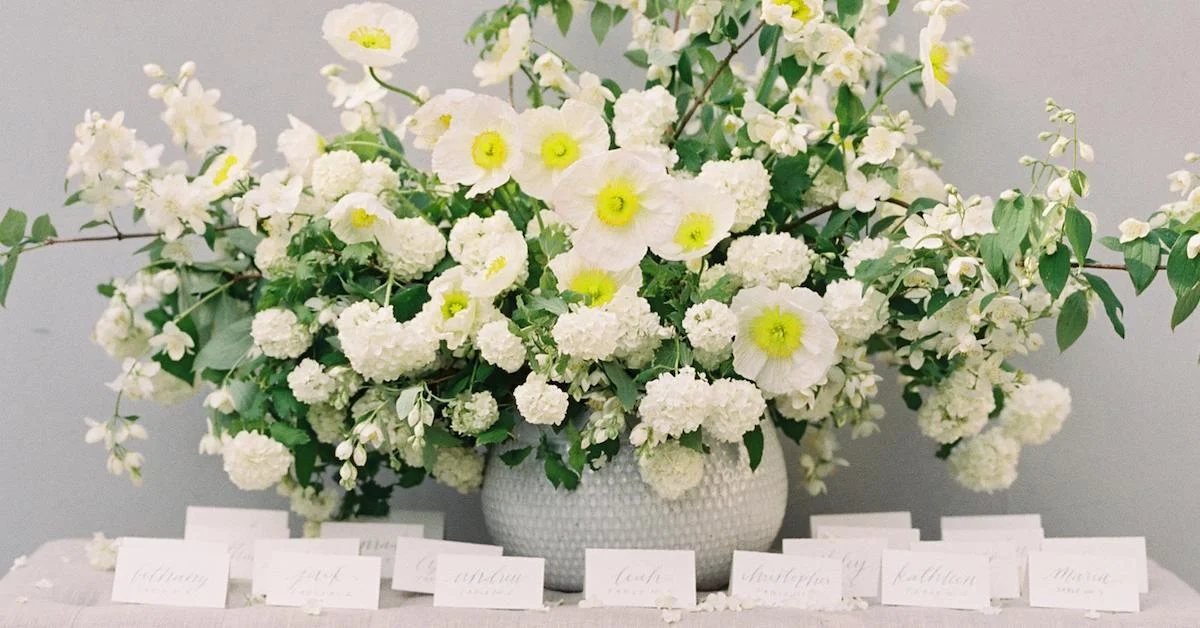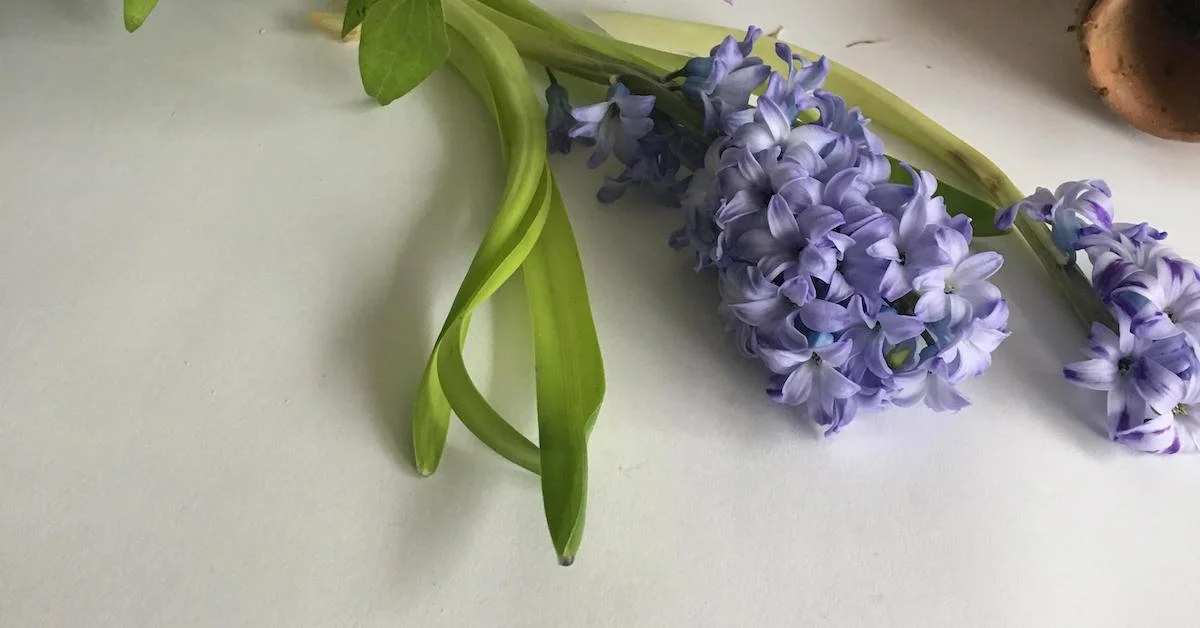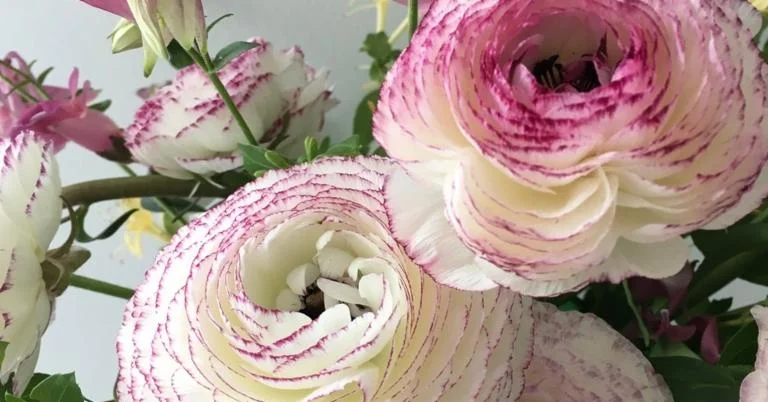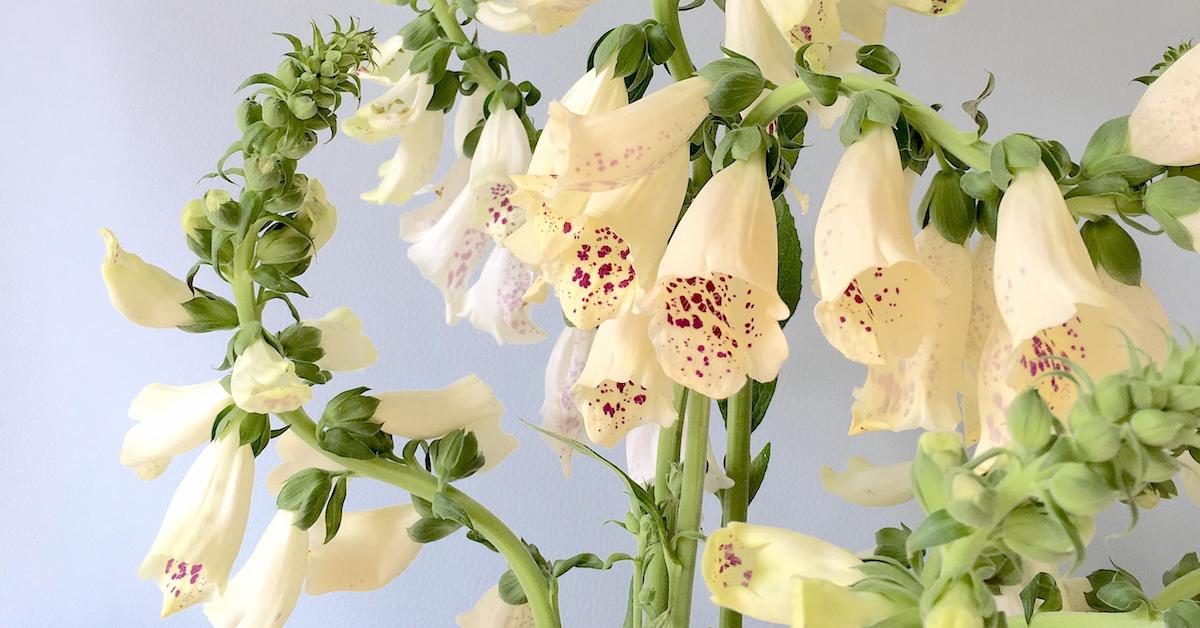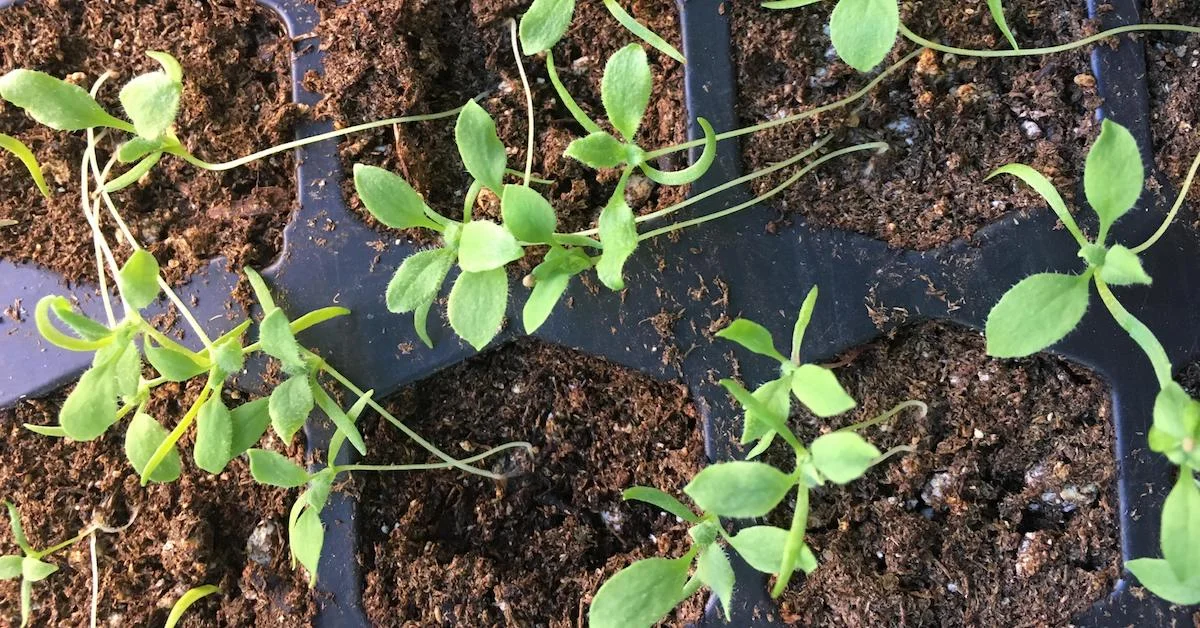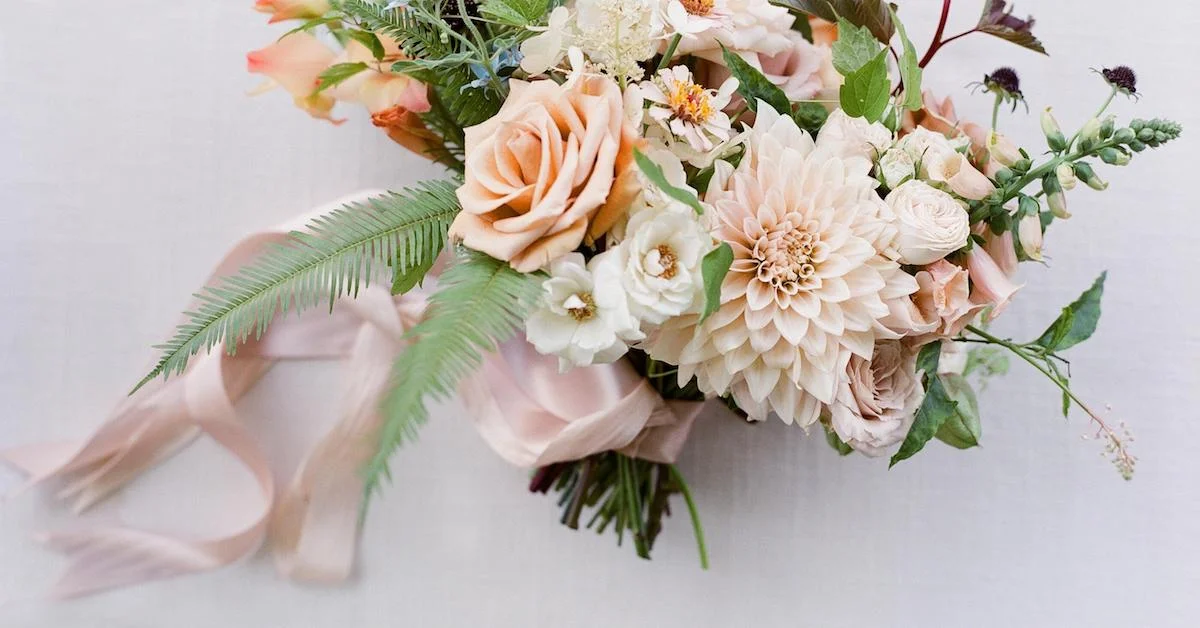In this video, Kelly uses one of her favorite planters from TJ Maxx with a liner for a fresh-flower arrangement. The key ingredients are Viburnum, Mock Orange, and Poppies. You'll learn about the undertone colors in flowers and how attention to this can bring unity to your ingredient choices. As you watch, notice that each of the flowers are of a creamy white color palette. However, they also bring in a yellow hint in the center of the flowers, especially the poppy and mock orange.
All in Videos
Video: How to Wire Flowers - Hyacinth
In this video, Kelly Perry of Team Flower demonstrates how to wire flowers for a floral comb. Wiring is a very important part of a florist’s toolkit as it allows you to do so many different things with various types of flowers. For this floral comb, Kelly is using white hyacinth and pieris.
Video: How to Use Complementary Colors in Your Floral Arrangements
Kelly demonstrates using complimentary colors in a small arrangement using only three ingredients. The ingredients used are Honeysuckle, Chantilly Snapdragons and Ranunculuses in a yellow and purple color scheme. As you’re choosing your ingredients, pay attention to the undertones of the colors in your flowers. This is key in creating a transition piece in your arrangement. Keep the triangular placement pattern in mind to create balance i.e. long piece on one side of the arrangement with a short and medium piece placed on the opposite side. Remember to disperse the colors evenly along with balancing each side to keep the arrangement symmetrical.
Video: How to Wire Large Flowers for Bouquets and More
In this excerpt from the Team Flower Advanced Wiring Techniques class, Kelly demonstrates how to wire large, over-sized flowers. Wiring flowers is a skill that can be incredibly useful as a floral designer. Not only does it enable you to move and direct a bloom in a specific direction, but it also allows for extra support for top-heavy flowers.
Video: Entry Arrangement using Foxglove and Columbine
This arrangement represents a quick-come-together piece if you have some leftover flowers at an event! You could place something like this on an escort card table, use it as decor for seat assignments, or as a beautiful addition to welcome guests into the ceremony space.
Video: You Can Transplant Cut Flowers—Here’s How
In this clip from the Foundations for Growing Cut Flowers class, Kelly from Team Flower and Kathleen from Primrose Hill Flower Co. are providing a hands-on example of transplanting your seedlings. You’ll want to be sure you have healthy balanced soil that crumbles in your hands. A common misconception in transplanting is the idea that the roots cannot be disturbed. In fact, it’s the exact opposite! The goal is for the roots to reach down and out in the soil, so loosening them up before planting is key. This also allows air to circulate through the roots and keeps them from tangling around one another.
Video: The Simple Way to Make a Boutonniere Using Wiring
Wiring leaves and flowers is such a helpful skill to have when doing small pieces like boutonnieres and gives you a lot of control on how the flowers lay and hold out of water. You’re able to bend each piece to fit and mold well with one another, and highlight those that need to be highlighted.
Video: Bouquet Ribbon Tips
Adding ribbon streamers to a bouquet can add a touch of whimsy to your design, and can be the perfect touch to the overall design for your client’s special day.
Video: Wedding Chair Flowers
Watch as Kelly Perry of Team Flower uses three materials to create a little extra magic for the bride and groom on their special day. Notice how quickly something sweet and elegant can be fashioned, and how little stress and skill it requires. Now, go grab your wire and your ribbon and forage a flexible vine to make one on your own!
Video: How to overcome perfectionism
In this video, Kelly begins a creatively inspired design made from ingredients from her garden. While she is purposefully designing something unique and professional, she is allowing herself freedom in expression - both in design and in color - as she chooses her ingredients and places each bloom.
Video: Late Summer Bridesmaid Bouquet
In this video you'll hear how Kelly approaches bridesmaid bouquets. Typically, the bridesmaid bouquet is a scaled back, smaller version of the bride’s more intricate bouquet. While often times the bridesmaid bouquet uses many of the same ingredients as the bridal bouquet, there are instances where the bridesmaids only utilize greenery so that the bride’s flowers pop even more. Ultimately, that decision is up to you - the designer!
Video: Photographing Flowers with a Paper Backdrop
This clip offers a sneak peek into the Team Flower How to Photograph Flowers Class. Heather Payne of Heather Payne Photography takes you behind the scenes when choosing a backdrop for photographing a flower arrangement. You’ll learn about using a simple paper backdrop, and how choosing various colors brings out the colors of the flowers in the design. Heather and Kelly discuss lighting, reflectors, and diffusers. Watch to receive tips on how you can take a simple yet great quality iPhone photo.
Video: Orange and Peach Bouquet
In this video we are going to make a late summer, three-level bouquet! Watch to see how Kelly implements design principles with each layer in the arrangement.
Video: Finding your Why for Arranging
In this video, Kelly shares the story behind her own design philosophy and challenges us to find our own flower story. Something inside all of us drives how we design, and ultimately determines the message that we send when we share our love of flowers with others.
Video: How to Wire Rose Buds
In this video, Kelly demonstrates two different ways to wire rose buds. These methods can be used in boutonniere's, corsages, and flower crowns and are excellent skills to add to you repertoire!
Video: Floral Table Arrangement Using Only 4 Ingredients
In this video, Kelly uses only a 4 ingredients to create a beautiful centerpiece. Baptisia takes color to the arrangement edges and Lady's Mantle gives us low coverage. Iris is on double duty by creating an implied line and offering a grouping of color to provide some rest in the arrangement.
Video: Principles and Elements of Design using Proximity
Have you ever thought about putting purpose behind how you choose your elements for design? In this video, Kelly explains how she used proximity to choose her elements, and explains the difference between choosing elements versus designing based on the design principle of proximity.
Video Quick Tip: Flower Installation Prep
Limited on event install time and need to attach flowers to something on site? This tip will make it possible for you to prep in advance and save time on wedding day! Watch as Kelly explains how she came across this idea, and how she's practicing using the yardstick to solve her installation time obstacle.
Video: Making Bouquets for Retail or Farmers’ Markets
In this video, Kelly shares how she thinks about creating bouquets for retail vs. bridal work using American Grown flowers.
———————————
Transcript:
- - We're back in the studio to put together a quick little farmer's market bouquet. I like to work one ingredient at a time, so I'm going to use five apple mint leaves, and just like when I'm creating a bridal bouquet, the apple mint leaves are giving me the shape and the structure that I'm going to use, but since the bouquets are going to be displayed in buckets, and people are walking up to them and looking down on them, the perspective that you arrange from is a little bit different than if you're doing a bridal bouquet that's going to be held here. So, I'm focusing on working, I'm just going to spiral the whole way around, and continue that with each of the ingredients that I have, celosia, and I'm working in layers because I do still want to have a little bit of ends and outs in my bouquet, and a variety of shapes and sizes. I'm going to add a little bit of cosmos in here, next. It gives me a completely different texture, really interesting. Now rather than using five, I'm just going to use three. And then I have a couple of pieces of basil we're working here, again three. Farmer's market bouquets, a lot of times you're doing, doing 'em all and doing 'em real quick, and you have a whole bunch to make, so if you can get yourself lined up, and you've got your pattern that you're working in, it's really easy to move quickly through the placement of the flowers. Last, but not least, I have zinnias, and these are our big, these are our big focal moment, and they're great because they're flat on top, and they have that nice face that's going to look up at all the passersby. Going to put the three smaller ones in, and then my three larger ones. That little bit of basil adds nice fragrance. Something, too, about farmer's market bouquets that are a little different than bridals, I think sometimes is that they're looking for something that's very bright and cheery, so color is very important in those types of settings, something that's very eye-catching and that people can see from far away, something that draws them in and over to your table. Made a lot of bouquets on the sidewalk last week. I'm just with some leftover flowers that I had from the workshop and the number one request was I want all colors, so it's different selling on the street than it is for bridals, so perhaps you're a wedding florist and not a farmer, but you want to do a pop-up shop or something like that, it's something to consider. It's so funny, some of the first bouquets I made whenever I started work for my friend that was a flower farmer, Mary Ellen, and she said, "No, really Kelly, like the first person "who comes up and buys flowers for his wife, "like he will want a really bright bouquet," and I was like, "Really?" 'Cause I'm the lady who wants the all-white bouquet, or something that's monochromatic, and sure enough, there I was at the market, and a man comes up, and he wanted the one with all the colors , and so I'd be curious to know what your experiences are, what your experiences are in that regard, since wow. I'm just going to give this a little clip here, tough to do, tough to do that with one hand There we go. So this is just a simple butcher's paper, and you can get it that it's wax side, a little bit water resistant, which is a little bit of water resistance, which is nice, and then also having this stand that you can tear from, I think, is really helpful as well. All kinds of ways that you can wrap, you're going to find the one that works the best for you and for your business, coordinates with the look of what you're going for. I have this cute little stand with some twine that I'll take with me when I do the little popups, but if you're doing farmer's market, you might want to get some clear sleeves, or you might want to have little baggies with water that you can have them sent home in, or something like that but that is up to you, but whenever I'm doing little sidewalk bouquets, that's what I like to do . There you go! Thanks for watching, and for taking a little tour through my seed patch.
Video: Instagram Marketing for Floral Businesses
In this replay of a Mayesh Live Chat webinar, Kelly walks through the Instagram strategy for @teamflower! You'll learn specific websites, tips and an overall mindset for when you use Instagram.

